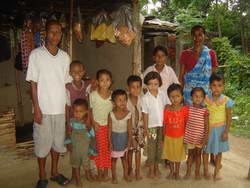 Meche
are mongoloid people whose origin and the date of arrival and settlement into
Nepal is not much clear. However, there are a few different views on their
settlement in Nepal.
Meche
are mongoloid people whose origin and the date of arrival and settlement into
Nepal is not much clear. However, there are a few different views on their
settlement in Nepal. Meche Folklore and Folklife:
A Close Observation
Introduction
The term Meche is used for both the folk group and the language which is a given term by outsiders. The folk group prefers to use Bodo for both the language and the people. Besides, the Meche people accept their relationship to Bodo folk group settled in Asam state of eastern India. Kachhari folk group in Bangladesh is also supposed to belong to the same group.
 Meche
are mongoloid people whose origin and the date of arrival and settlement into
Nepal is not much clear. However, there are a few different views on their
settlement in Nepal.
Meche
are mongoloid people whose origin and the date of arrival and settlement into
Nepal is not much clear. However, there are a few different views on their
settlement in Nepal.
One of these views relates the group to Mahabharata era. According to the view king Vanasura Meche was ruling in the state somewhere in the present Nepal territory which was defeated by Krishna. Krishna, then, established the Gopal dynasty. Gopal dynasty is the oldest dynasty recorded in Nepalese history. This view introduces Meche folk group as first settlers of Nepal.
Another view about Meche is that a group departed from Tibet was divided into three sub groups and one went to Asam in India and settled there which is known as Bodo, another group went to present Bangladesh and settled there which is known as Kachhari and third group came to east Nepal and settled there which is known as Meche.
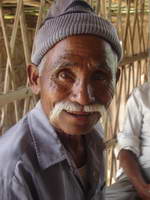
According to the third view Rai, Limbu and Meche were three brothers who are settled in eastern hills of present Nepal. They went to Terai for the search of job. After twelve years, they decided to return back for their home. While preparing to returning back Meche got a bit late and Rai and Limbu left him. Meche tried to follow them but failed. He was lost on the way and remained in the jungle. He settled on the riverside in the jungle of eastern Terai of present Nepal. His descendants are known as Meche people now.
Settlement and population
Meche folk group is settled mainly in Jhapa and also found in a very few number in Sunsari and Morang districts of Nepal. According to the census report 2001, the total population of this group is 3763. Meche has altogether twelve clans these include – 1) Gayari, 2) Narjihari, 3) Wasamothari, 4) Machhahari, 5) Harjidhari, 6) Chhangphranghari, 7) Raungadiyari, 8) Owahari, 9) Daimari, 10) Khunthaiyari, 11) Kharjiyari, 12) Sanyasiyari.
House construction and use
Houses in the Meche settlement are found scattered instead of dense.
Though they prefer to have Meche people as their
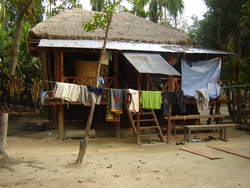 neighbors,
there are other people also found among their villages now. Almost all the
houses in Meche villages are in the same structure. The houses are built
around the open yard. There is a shrine of ancestral deity called Bathau
at the middle of the yard which is in front of main building that is faced
south. The house has two rooms inside – kitchen and the bed room which are
opposite to each other. Around the yard there are other buildings like cowshed,
cages for pigs and hens etc. Most of the traditional buildings are made of
bamboo, mud, and hay.
neighbors,
there are other people also found among their villages now. Almost all the
houses in Meche villages are in the same structure. The houses are built
around the open yard. There is a shrine of ancestral deity called Bathau
at the middle of the yard which is in front of main building that is faced
south. The house has two rooms inside – kitchen and the bed room which are
opposite to each other. Around the yard there are other buildings like cowshed,
cages for pigs and hens etc. Most of the traditional buildings are made of
bamboo, mud, and hay.
Society and family structure
Meche people have their own chief of the village called Mankhal who serves as an administrative as well as judicial head of the village. He settles the cases among Meche people within the community. There is Roja who serves as priest in the society. Phanthol is the assistant of Roja.
Nuclear family is common among Meche folk group because son and daughter leave their parents after they get married.
Meche Language
Meche
language is spoken by Meche folk group as their mother tongue. It is
placed under East Himalayish subgroup of Himalayish group of the Bodic
section of Tibeto-Burman languages of Sino-Tibetan language family in the
genetic classification. It is g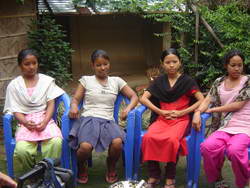 enetically
close to Kirati languages and aerially close to Nepali, Rajbanshi, Bangali,
Hindi and Asami.
enetically
close to Kirati languages and aerially close to Nepali, Rajbanshi, Bangali,
Hindi and Asami.
The language is not yet used in education, mass media and in the office. Mother tongue speakers of this language are 3301 out of 3763 total Meche people. Most of the Meche people are bilingual and multilingual. However, very few old Meche people are found monolingual. The bilingual or multilingual people speak Nepali, Hindi, Bengali and Rajbanshi as their second language. They have positive attitude towards their language.
The language has no written tradition and its own orthography yet. It is highly influenced by Nepali. The language has 6 vowels and 15 consonants. It has singular and plural two numbers, past and non past two tenses, perfective and progressive two aspects, and indicative, interrogative, imperative, and optative four moods. Meche is S(ubject) O(bject) V(erb) language in terms of word order.
Folk belief
Meche folk group have some beliefs about omen. Crawling of a dog, crossing the road by cat and snake, meeting with the corpse while going out for some auspicious work, and crowing of the crow near house are supposed to be bad omens. If the cocks or hens fight they believe that the guests will come. To see the pot with full water is good omen for this group.
Folk god/goddess and Festivals
The
gods and goddesses that Meche people worship are classified into three
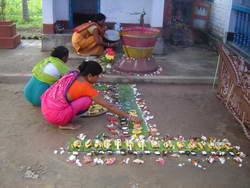 types
– nonimodai (gods of house), dainimodai (gods of river) and
gaminanimodai (gods of village). Bathau is their ancestral god. They
worship the god Shiva in Bathau and goddess Balikhungi (Parvati)
in Nomano. They also worship god of land and the god of village.
Sansari gram puja is performed collectively which is the
worship of village god. They perform lakhi puja in Tihar
and maijagawai puja while planting rice.
types
– nonimodai (gods of house), dainimodai (gods of river) and
gaminanimodai (gods of village). Bathau is their ancestral god. They
worship the god Shiva in Bathau and goddess Balikhungi (Parvati)
in Nomano. They also worship god of land and the god of village.
Sansari gram puja is performed collectively which is the
worship of village god. They perform lakhi puja in Tihar
and maijagawai puja while planting rice.
Vaishagu, phagua, shiruwa, tihar are observed mainly in the community. Now, they also perform dashain and other festivals by the influence of other communities.
Folk dresses and ornaments
The
traditional dresses of the male member of Meche folk group is loin cloth,
gamchha
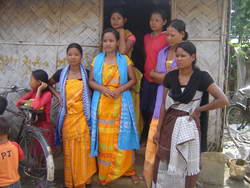 (a
towel like wrapper for lower part of the body up to the knees), dhoti (a
wrapper cloth for man like sari for woman), vest and waist coat where the
traditional dress for the female member is dokhana (a kind of wrapper
which covers the breast and the lower part of the body) and shawl. Now, modern
dresses like shirt, pant, T-shirt, etc. are also used. They wear the traditional
dresses in the religious and cultural ceremonies.
(a
towel like wrapper for lower part of the body up to the knees), dhoti (a
wrapper cloth for man like sari for woman), vest and waist coat where the
traditional dress for the female member is dokhana (a kind of wrapper
which covers the breast and the lower part of the body) and shawl. Now, modern
dresses like shirt, pant, T-shirt, etc. are also used. They wear the traditional
dresses in the religious and cultural ceremonies.
Meche men do not wear any ornaments but the women wear silver ornaments in their noze, ear, neck, arms, wrist and feet like chandrahal, thakhahar, inthi, nakhaphul, Basthari, authi, samkha, gotmala, khuchchiyamala, nathiya, achhan, pauju. etc.
Folk medical treatment
Roja (the priest) has the knowledge and practice of the traditional folk medicine among Meche folk group which is based on herbal medicine. The Roja does not let other people know about the herbs that are used as medicine with the belief that if other people know the herbs that does not work.
Folk literature
There are different genres of folk literature found in practice in Meche folk group like folk tale, folk song, proverb, idiom, riddle and folk sayings. The folk tales cover various topics like their origin, nature and animals, traditional technology, nature and profession of man, etc. There are different types of songs in practice. Religious songs like hymns, appreciation of the gods and goddesses are in practice. There are also duet songs.
Folk performing arts
There are folk dramas, folk dances and folk music performed among the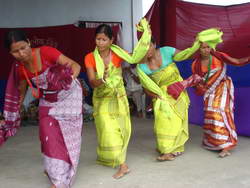 folk group. It is informed that the folk drama based on the folktale
Khurikhatta khurikhatti buraburi (woodcutter old couple) has performed for
whole night few years ago in the community but there is no information about how
old is the tradition. Among the major folk dances dauwo dance is
performed in phagua, mosabai hawa is performed with flute by women in the
marriage ceremony, and chorkhela bajlobai is performed in Tihar.
There are different folk musics performed with traditional musical instruments
among the community.
folk group. It is informed that the folk drama based on the folktale
Khurikhatta khurikhatti buraburi (woodcutter old couple) has performed for
whole night few years ago in the community but there is no information about how
old is the tradition. Among the major folk dances dauwo dance is
performed in phagua, mosabai hawa is performed with flute by women in the
marriage ceremony, and chorkhela bajlobai is performed in Tihar.
There are different folk musics performed with traditional musical instruments
among the community.
Folk tools and weapons
There are several folk tools and weapons found among Meche folk group
which are used in hunting,
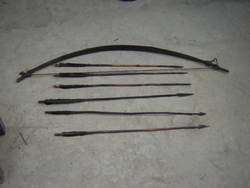 farming,
fishing, etc. that are the major traditional occupations. These are classified
into three groups – metal tools, wooden tools, bamboo tools. Trishul, khukuri,
spear, arrow, hasiya, axe, chulesi, kanasi, khochha, guleli,
plough, kuto, spade, hammer, etc. are the metal tools while spear,
guleli, dhera, plough, yoke, etc. are the wooden tools. Bow, khola,
burung, phati, phulung, pat,. etc. are the bamboo tools.
farming,
fishing, etc. that are the major traditional occupations. These are classified
into three groups – metal tools, wooden tools, bamboo tools. Trishul, khukuri,
spear, arrow, hasiya, axe, chulesi, kanasi, khochha, guleli,
plough, kuto, spade, hammer, etc. are the metal tools while spear,
guleli, dhera, plough, yoke, etc. are the wooden tools. Bow, khola,
burung, phati, phulung, pat,. etc. are the bamboo tools.
Folk games and entertainments
Traditional folk games popular in Meche community are khomdalainu (wrestling), khaude bima, gallau (long jump), gajau (high jump), samthrinai (swimming), bitti (stick game), gatti khel, chatti khel, kukhura khel, phing (swing), jolunga (swing), thuka khel (bow and arrow), chakum khel, damphil, dhus, khopi, amli, etc. Now, these are not so popular instead T.V. and Radio are the popular means of entertainment.
Folk musical instruments
Basuri
(flute), bakhalto (a musical instrument made of bamboo), granggring,
jotha
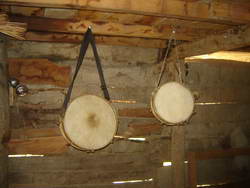 (a
small kind of cymbal) are very popular musical instruments among Meche
folk group while the traditional musical instruments like dhak (a huge
drum), kham (a small drum), serenja (instrument like sarangi),
dothra or dottara (instrument like guitar) are not in practice
today. Instead of these traditional instruments tabla and harmonium are being
more popular nowadays.
(a
small kind of cymbal) are very popular musical instruments among Meche
folk group while the traditional musical instruments like dhak (a huge
drum), kham (a small drum), serenja (instrument like sarangi),
dothra or dottara (instrument like guitar) are not in practice
today. Instead of these traditional instruments tabla and harmonium are being
more popular nowadays.
Traditional knowledge and technology
Meche folk group has knowledge of preparing all the traditional tools and instruments, and goods that are the parts of their daily life. They have knowledge of preparing wine for drink, cloths like dokhana, shawl, gamchha, etc., ropes, preparing house, preparing plough, yoke, fishing tools, and fishing. Now, these traditional knowledge and skills are gradually losing from the community.
Gender issues and decision making procedure
Meche women are involved in wine producing, pig keeping, farming, and working in the wood factories. It makes themselves independent on economic matters. They are more forward than the male members of the society in education. They participate in decision making process within the family.
Rites of the passage
Jalam (the birth rite)
While a woman gives birth to a baby older women in the community care her and the newly born baby. The placenta is buried near the house. There used to be the tradition when the birth labor begins the mother is kept inside nomano (the building of goddess Parvati). The people promise to offer the child to the god because of the belief that the child will be healthy. They use bamboo slits to cut the umbilical cords. There are five slits if the child is girl and there are seven slits if the child is boy to cut the umbilical cord.
The name giving ceremony is performed when the umbilical cord gets separate completely.
Rice feeding
There is no fix date for the rice feeding ceremony in Meche community,
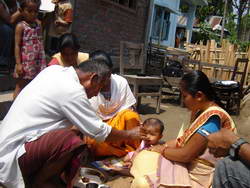 when
the child wants to eat rice they fix the date and feed the rice. So, it seems a
newly established tradition among this group. It may be the influence of other
communities over this community. However, there is certain procedure which is
followed while rice feeding the child. There is a cactus tree inside the fence
of bamboo in front of nomano. The child is taken to the side of the tree.
Banana leaves, flowers, fragrances, string, fruits, and burning lamp with oil
and cotton string are gathered and worshiped in Bathau. Then the child is
fed rice.
when
the child wants to eat rice they fix the date and feed the rice. So, it seems a
newly established tradition among this group. It may be the influence of other
communities over this community. However, there is certain procedure which is
followed while rice feeding the child. There is a cactus tree inside the fence
of bamboo in front of nomano. The child is taken to the side of the tree.
Banana leaves, flowers, fragrances, string, fruits, and burning lamp with oil
and cotton string are gathered and worshiped in Bathau. Then the child is
fed rice.
Marriage
There are seven types of marriage found in practice among Meche folk
group. Among those
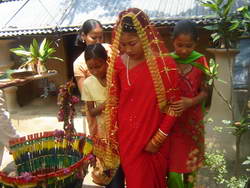 Magi
vivaha is arrange marriage in which goida (mediator) proposes the
marriage and mediates the communication between the boy’s and the girl’s sides
and arranges the meetings. When both sides are positive, the marriage is
proposed formally. Three women and two men go to the girl’s house and put few
coins at Bathau to buy the girl which is the formal proposal. If the
girl’s parents return the coins the marriage supposed to be denied and if they
accept the coins it is supposed to be accepted. When the marriage is accepted,
the people from the boy’s side go to the girl’s house with vessels of wine and
rice (uncooked) to decide about the marriage. There is also a pack of betel and
betel nut with rice.
Magi
vivaha is arrange marriage in which goida (mediator) proposes the
marriage and mediates the communication between the boy’s and the girl’s sides
and arranges the meetings. When both sides are positive, the marriage is
proposed formally. Three women and two men go to the girl’s house and put few
coins at Bathau to buy the girl which is the formal proposal. If the
girl’s parents return the coins the marriage supposed to be denied and if they
accept the coins it is supposed to be accepted. When the marriage is accepted,
the people from the boy’s side go to the girl’s house with vessels of wine and
rice (uncooked) to decide about the marriage. There is also a pack of betel and
betel nut with rice.
There is an interesting bargaining between the bride and the bridegroom sides. Flute and pigs are demanded by the bride’s side. They also bargain for the dresses and ornaments. The debate also includes the musical instruments and the players for the marriage. At the end all the things are settled and the date of the marriage is fixed. The relatives are invited with the couple of bundles of betel. The marriage procession without bridegroom is taken to the bride’s house on Tuesday evening and brings her to the bridegroom’s house on Wednesday. The number of people is just doubled while coming back to the bridegroom’s house. A cock and a hen are slaughtered and the heads are thrown towards Bathau. The heads face to the east is supposed to be good in the community.
Among other types Ghichchyaune vivaha is one in which a girl is captured and married to a boy without her interest and consensus. The people from the boy’s side carry the girl on the back to the boy’s house while she is alone. Bhagi vivaha is a love marriage. It is performed without the permission from the guardians. Randarandi vivaha is the marriage between a widow and a widower. Gharjwain vivaha is a marriage in which a bridegroom lives in the bride’s house after marriage. Normally it is applicable between the boy who has no parents and the girl who has no brothers. Dangowa vivaha is a vivaha between a widow with children and a man. The man may be either married or unmarried. He goes to the widow’s house and takes care of the children of the woman. When a girl goes to the boy’s house and lives there as a wife though the boy does not want to marry with her it is called Khasunnai vivaha which is opposite to Ghichyaune vivaha. For this, the girl goes with a jar of water and washes the boy’s feet saying “I am your wife.” There is also a practice of polygamy.
Death
The
relatives are called when someone dies among the Meche folk group. The
dead body is kept on the ground which is smeared with cow dung. The body is
headed towards south. If the person has daughter and son in law their presence
is compulsory, the corpse is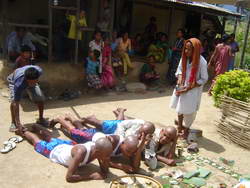 not taken to the grave until they come. After the death of a person his or her
son and daughter in law have to have a bath and rub oil on the body. All the
relatives put the water in the dead body’s mouth from the bowl with coin. The
corpse is fed rice with meat and offered money. Narjihari cuts the hair
of the son, so he gets the money offered to the dead body. The carrier is made
of bamboo and the corpse is tied in the carrier with bamboo slits. There are
seven slits to tie if the dead person is female and five slits if the dead
person is male. Roja offers the sacred grass with a jar of water and says
“go and stay comfortably” to the dead body as farewell.
not taken to the grave until they come. After the death of a person his or her
son and daughter in law have to have a bath and rub oil on the body. All the
relatives put the water in the dead body’s mouth from the bowl with coin. The
corpse is fed rice with meat and offered money. Narjihari cuts the hair
of the son, so he gets the money offered to the dead body. The carrier is made
of bamboo and the corpse is tied in the carrier with bamboo slits. There are
seven slits to tie if the dead person is female and five slits if the dead
person is male. Roja offers the sacred grass with a jar of water and says
“go and stay comfortably” to the dead body as farewell.
The eldest son carries the corpse from the front side. Male and female both participate in the funeral procession. The corpse is buried on the grave. Before digging the trench, the land should be bought from the earth with a little money. While the corpse is buried a hole with bamboo slits is made with the belief that the dead body can have respiration. Chicken is offered to the body which is cooked at home and carried with. After it is buried, the four poles of bamboo are driven and pieces of cloths are put as a signal.
The eldest son should stay separate for mourning and perform all the rites. If the eldest son is not available, the youngest son should perform all the rites. In case the youngest son also not available, the elder than that should perform all the rites.
If the dead person is child before it has teeth, the mourning period is three days, if it is the child with teeth, the period is five days and in other cases it is nine days. The mourner should offer rice and vegetable to three gods everyday before meal.
On the tenth day, all the relatives are gathered; people have bath for purification; the narjihari sprays around the pure water from the bowl with sacred grass; and Roja worships on Bathau. There is a feast with chicken and pork. The family is purified with this ceremony.
Economic life and livelihood
Meche people are found in low-middle class in terms of economic status in average. Their traditional occupations are farming, hunting and fishing. There is no jungle for hunting while fishing is only occasional and it is done for hobby today. Now, they are mainly involved in agriculture, animal husbandry, business and work in the private companies. Foreign employment is also a flowering occupation among this folk group.
They produce rice, maize, vegetables and fruits from the field. Their main food is rice but they also use baked maize. Chilly, ginger, onion, radish, pumpkin, different kinds of gourds and leafy vegetables are the main items of vegetables they produce while mango, coconut, jackfruit, pineapple, etc. are the main fruits they produce. Vegetables and fruits are the main resources of income from the agriculture.
Traditional ethnic institutions
Meche folk group has its own traditional institution in which there are three posts to run the society – Mankhal (Chief of the society), Roja (folk medicine practitioner), and Phanthol (priest). But, the tradition to choose Mankhal is gradually disappearing because there is a concept that Mankhal exploits the people.
Concluding remarks
The Meche is one of the folk groups settled in east-southern part of Nepal with their rich cultural heritage. They have their own way of life with traditional institution, language, societal structure, knowledge and technology, and the tools, instruments, objects, literature, etc. as the products of their minds. However, the group is on the pressure of other’s ways of life, culture, and knowledge and technology because of the heavy influence in their ways and the changes on the global situation. Thus, has become endangered folk group.
Prepared by: Mr. Tej Prakash Shrestha, Mr.Ram Kumar Shrestha, Mr. Suren Sapkota and Mr. Rohini Raj Nepal
Translated by: Mr. Bhim Narayan Regmi.